
Georges Braque was a major 20th-century French painter, collagist, draughtsman, printmaker and sculptor. His most notable contributions were in his alliance with Fauvism from 1905, and the role he played in the development of Cubism. Braque's work between 1908 and 1912 is closely associated with that of his colleague Pablo Picasso. Their respective Cubist works were indistinguishable for many years, yet the quiet nature of Braque was partially eclipsed by the fame and notoriety of Picasso.

Lithography is a planographic method of printing originally based on the immiscibility of oil and water. The printing is from a stone or a metal plate with a smooth surface. It was invented in 1796 by the German author and actor Alois Senefelder and was initially used mostly for musical scores and maps. Lithography can be used to print text or images onto paper or other suitable material. A lithograph is something printed by lithography, but this term is only used for fine art prints and some other, mostly older, types of printed matter, not for those made by modern commercial lithography.

Cubism is an early-20th-century avant-garde art movement that revolutionized European painting and sculpture, and inspired related artistic movements in music, literature, and architecture. In Cubist works of art, the subjects are analysed, broken up, and reassembled in an abstract form—instead of depicting objects from a single perspective, the artist depicts the subject from multiple perspectives to represent the subject in a greater context. Cubism has been considered the most influential art movement of the 20th century. The term cubism is broadly associated with a variety of artworks produced in Paris or near Paris (Puteaux) during the 1910s and throughout the 1920s.
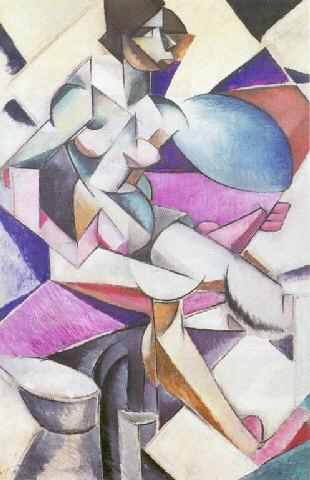
Mariya Ivanovna Vassiliéva, , better known as Marie Vassilieff, was a Russian-born painter active in Paris.
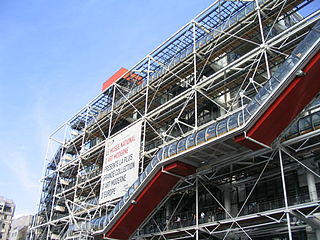
The Musée National d'Art Moderne is the national museum for modern art of France. It is located in Paris and is housed in the Centre Pompidou in the 4th arrondissement of the city. In 2021 it ranked 10th in the list of most visited art museums in the world, with 1,501,040 visitors. It is one of the largest museums for modern and contemporary art.
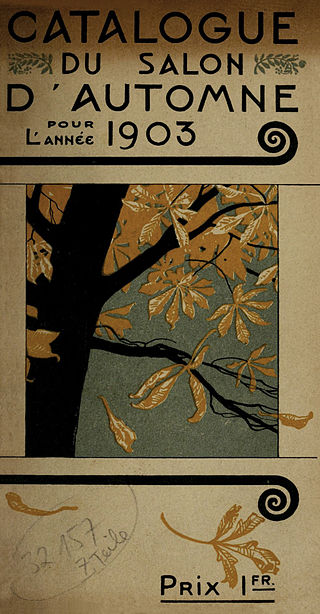
The Salon d'Automne, or Société du Salon d'automne, is an art exhibition held annually in Paris. Since 2011, it is held on the Champs-Élysées, between the Grand Palais and the Petit Palais, in mid-October. The first Salon d'Automne was created in 1903 by Frantz Jourdain, with Hector Guimard, George Desvallières, Eugène Carrière, Félix Vallotton, Édouard Vuillard, Eugène Chigot and Maison Jansen.
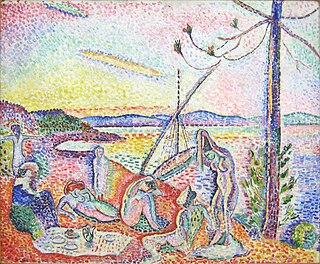
The Société des Artistes Indépendants or Salon des Indépendants was formed in Paris on 29 July 1884. The association began with the organization of massive exhibitions in Paris, choosing the slogan "sans jury ni récompense". Albert Dubois-Pillet, Odilon Redon, Georges Seurat and Paul Signac were among its founders. For the following three decades their annual exhibitions set the trends in art of the early 20th century, along with the Salon d'Automne. This is where artworks were often first displayed and widely discussed. World War I brought a closure to the salon, though the Artistes Indépendants remained active. Since 1920, the headquarters has been located in the vast basements of the Grand Palais.
Artists Rights Society (ARS) is a copyright, licensing, and monitoring organization for visual artists in the United States. Founded in 1987, ARS is a member of the International Confederation of Societies of Authors and Composers and as such represents in the United States the intellectual property rights interests of over 122,000 visual artists and estates of visual artists from around the world.

Jean René Bazaine was a French painter, designer of stained glass windows and writer. He was the great great grandson of the English Court portraitist Sir George Hayter.

Marie-Alain Couturier, O.P., was a French Dominican friar and Catholic priest, who gained fame as a designer of stained glass windows. He was noted for his modern inspiration in the field of Sacred art.

Fernand Mourlot, son of Jules Mourlot, was the director of Mourlot Studios and founder of Editions Mourlot.
Gaston Diehl was a French professor of art history and an art critic.
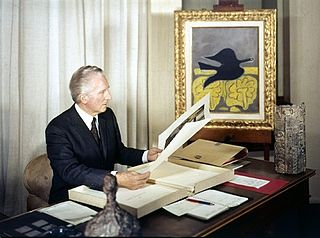
Aimé Maeght was a French art dealer, collector, lithographer, and publisher. He founded the Galerie Maeght in Paris and Barcelona, and the Fondation Maeght in Saint-Paul-de-Vence near Nice. Though the original Flemish pronunciation is pronounced "," the French pronunciation of surname Maeght sounds more similar to.

Aldo Crommelynck was a Belgian master printmaker who made intaglio prints in collaboration with many important European and American artists of the 20th century. At the time of his death, The Guardian termed Crommelynck the 'pre-eminent' and 'the most celebrated printmaker of the second half of the 20th century.'

Le pigeon aux petit pois, sometimes referred to as Dove with green peas, is a 1911 oil on canvas painting by Pablo Picasso. It is an example of Picasso's Cubist works and has an estimated value of €23 million. The painting was one of five artworks stolen from the Musée d'Art Moderne de la Ville de Paris on 20 May 2010, which together are valued at €100 million. It has so far not been recovered and its whereabouts remain unknown.

Marie Cuttoli was a French entrepreneur, born in Tulle, and patron of modernist tapestry.

Proto-Cubism is an intermediary transition phase in the history of art chronologically extending from 1906 to 1910. Evidence suggests that the production of proto-Cubist paintings resulted from a wide-ranging series of experiments, circumstances, influences and conditions, rather than from one isolated static event, trajectory, artist or discourse. With its roots stemming from at least the late 19th century, this period is characterized by a move towards the radical geometrization of form and a reduction or limitation of the color palette. It is essentially the first experimental and exploratory phase of an art movement that would become altogether more extreme, known from the spring of 1911 as Cubism.

King & McGaw is an art publisher and online retailer. It supplies high quality art prints and products to museums, galleries and retail stores as well as art prints direct to consumers through its online retail site. Production is based in their 50,000 sq ft (4,600 m2) factory in Newhaven, Sussex.

Theodor "Teto" Ahrenberg was a Swedish businessman and collector. His extensive collection featured works by artists such as Pablo Picasso, Henri Matisse, Marc Chagall, Le Corbusier, Olle Bærtling, Sam Francis, Mark Tobey, Christo, Lucio Fontana, Tadeusz Kantor, Enrico Baj, Jean Tinguely, and Niki de Saint Phalle. Key works in the collection included the two versions of Matisse's Apollo (1953), Picasso's Nude in a rocking chair (1956) and Chagall's Les mariés sous le baldaquin (1949).

Dove is a 1949 lithograph on paper created by Pablo Picasso in 1949 in an edition of 50+5. The lithograph displays a white dove on a black background, which is widely considered to be a symbol of peace. The image was used to illustrate a poster at the 1949 Paris Peace Congress and also became an iconographic image of the period, known as "The dove of peace". An example is housed in the collection of the Tate Gallery and MOMA. Since then, it has been considered a masterpiece.


















